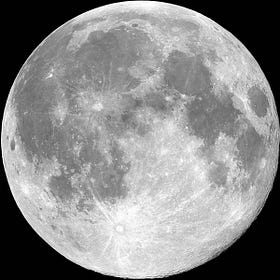“Comets are like cats: they have tails, and they do precisely what they want.”
— David H. Levy
Greetings, fellow Bohron.
The universe has sent us a gift—a piece of cosmic debris from another star system. July 2025 began with an incredible discovery when astronomers detected the third such interstellar traveler ever found: 3I/ATLAS. Its discovery has reignited excitement across the astronomical community, revealing a profound story about cosmic wanderers, the birth of stars, and the shared history of the galaxy.

What makes 3I/ATLAS special? Why does it matter? What can it teach us about our place in the cosmos?
Note: This article is about a relatively new discovery. The comet is being closely monitored at the moment. The given numerical values of various parameters might not be exact and are expected to improve in the future.☄️ What Is 3I/ATLAS?
Discovered on July 1, 2025, by the Asteroid Terrestrial-impact Last Alert System (ATLAS) telescope in Chile, 3I/ATLAS immediately stood out because of its unusual, hyperbolic orbit. In astronomy, "I" stands for "interstellar," and this is only the third object ever confirmed to come from outside our solar system, after:
1I/ʻOumuamua (2017): The mysterious, elongated object that puzzled astronomers with its strange acceleration and shape.
2I/Borisov (2019): A comet-like object rich in gas and dust, behaving much more like typical solar system comets.
Characteristics:
Diameter: 15 km (uncertainty is significantly large, it might be 20 km wide)
Velocity: 61 km/s (will reach a maximum of 68 km/s at its perihelion)
Distance of Closest Approach from Earth: 270 million kilometers (1.8 AU) on Dec. 19, 2025.
Perihelion: 203 million km (1.36 AU) on Oct. 29, 2025.
Eccentricity: 6.12

🌠 A Journey from the Stars
Unlike comets born in the icy outskirts of our own solar system, interstellar objects are cosmic refugees. They formed around distant stars, only to be ejected by gravitational interactions, perhaps with giant planets or passing stars.
For untold millions of years, they drift in interstellar space, carrying clues about the chemistry and physics of other planetary systems.
3I/ATLAS’s hyperbolic orbit means it isn’t bound to the Sun. It’s just passing through, coming in from deep space, swinging around the Sun, and heading back out, never to return.
🔭 Why Astronomers Are Excited?
Interstellar objects are natural space probes, samples of material from other solar systems delivered straight to our cosmic doorstep. Studying them can:
Reveal how planets form elsewhere.
Show if chemical building blocks of life are common across the galaxy.
Test whether our solar system is unique or just one of countless planetary families.
With only two previous interstellar visitors known, each new discovery is a chance to gather more data and refine our theories.
📅 What Happens Next

September 2025: Astronomers will track 3I/ATLAS as it approaches the Sun, carefully measuring its brightness, composition, and orbit.
Late October 2025: It will swing just inside Mars’ orbit, still far from Earth, so it poses no danger.
November–December 2025: It will pass behind the Sun from our perspective, temporarily disappearing from view.
December 2025 onward: 3I/ATLAS re-emerges into the morning sky, fainter and on its way back to the galaxy.
Although it may not be visible to the naked eye, powerful telescopes worldwide are already planning detailed observations.
🔬 Breaking Down the Science
Interstellar object: An object whose path shows it isn’t gravitationally bound to the Sun, it comes from outside the solar system.
Hyperbolic orbit: A path shaped like an open curve, meaning the object passes by once and escapes forever.
Astronomical Unit (AU): The average distance from Earth to the Sun, about 150 million km.
Comet nucleus: The solid, central part of a comet, made mostly of rock and ice.
Outgassing: When a comet heats up near the Sun, it releases gas and dust that form a visible coma and tail.
🌌 What We've Learned from Its Predecessors
ʻOumuamua: Its bizarre shape and unexplained acceleration sparked debates—was it icy, metallic, or something stranger?
2I/Borisov: Much more familiar—a comet rich in carbon monoxide (CO), amines (R-NH2), and water (H2O), hinting that other planetary systems form similar icy bodies.
With 3I/ATLAS, astronomers hope to see whether it resembles Borisov (a typical comet) or has its own surprises in store.

🔮 Looking to the Future
Later this month, the Hubble Space Telescope will also take pictures of the comet. Explore the new discovery more at The Sky Live.
Astronomers will use every tool, optical telescopes, spectroscopes, and maybe even radio observations, to learn as much as possible before 3I/ATLAS vanishes into the dark.
These messengers tell a story billions of years in the making, linking us to stars and planets light-years away. Sometimes, the universe can come knocking at our door.
References:
Comet 3I/ATLAS - NASA Science
New interstellar object 3I/ATLAS: Everything we know about the rare cosmic visitor - Space.com
3I/ATLAS - Wikipedia





I see. But it's about money. People pay taxes. You wouldn't want to take the biggest risk of spending that money on such speculations backed by little to no concrete evidence. These things might be true, no doubt about that. But it's about focusing your energy, your resources, and money on matters that matter. Some groups already protest against the money being spent on space exploration and particle accelerators. Imagine how much outrage would occur if governments were to tell their people that billions are being spent to find aliens!
its definitely a rare sight to have such guests in our neighbourhood. Its all fun until they decide to pay us a visit personally😅.